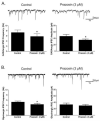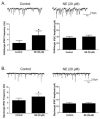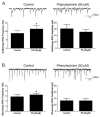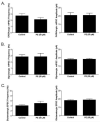α1-adrenergic receptors facilitate inhibitory neurotransmission to cardiac vagal neurons in the nucleus ambiguus
- PMID: 21771639
- PMCID: PMC3171606
- DOI: 10.1016/j.neuroscience.2011.07.024
α1-adrenergic receptors facilitate inhibitory neurotransmission to cardiac vagal neurons in the nucleus ambiguus
Abstract
The cholinergic cardiac vagal neurons (CVNs), located in the nucleus ambiguus, are the origin of cardioinhibitory parasympathetic activity. Catecholaminergic neurons in nearby regions of the brainstem, including the C1 and C2 cell groups, are thought to play a key role in both arousing from sleep and maintaining wakefulness. Because norepinephrine (NE) could play an important role in influencing the activity of CVNs, particularly in response to sleeping/waking and arousal states, the present study investigated the contribution of α(1)-adrenergic receptor activation to augment inhibitory and/or blunt excitatory neurotransmission to CVNs. To test the effects of α(1)-adrenergic receptor activation, CVNs were labeled in rats by retrograde tracing and synaptic events were recorded by whole cell voltage clamp techniques in vitro. Prazosin, an inverse agonist of α(1)-adrenergic receptor, significantly decreased the frequency of both GABAergic and glycinergic neurotransmission to CVNs. Activation of α(1)-adrenergic receptors by the α(1)-adrenergic receptor agonists NE or phenylephrine (PE) both significantly increased GABAergic and glycinergic inhibitory event frequency. This effect was prevented by the sodium channel blocker tetrodotoxin (TTX). Activation of α(1)-adrenergic receptors did not alter glutamatergic neurotransmission to CVNs. This study indicates that α(1)-adrenergic receptor activation in the brainstem can facilitate inhibitory GABAergic and glycinergic neurotransmission so as to reduce CVN activity; this synaptic modulation may play a role in the tachycardia seen during NE-dependent behavioral arousal.
Copyright © 2011 IBRO. Published by Elsevier Ltd. All rights reserved.
Figures





Similar articles
-
Activation of D2-like dopamine receptors inhibits GABA and glycinergic neurotransmission to pre-motor cardiac vagal neurons in the nucleus ambiguus.Neuroscience. 2013 Sep 5;247:213-26. doi: 10.1016/j.neuroscience.2013.05.039. Epub 2013 May 29. Neuroscience. 2013. PMID: 23727508 Free PMC article.
-
β adrenergic receptor modulation of neurotransmission to cardiac vagal neurons in the nucleus ambiguus.Neuroscience. 2012 May 17;210:58-66. doi: 10.1016/j.neuroscience.2012.02.033. Epub 2012 Feb 24. Neuroscience. 2012. PMID: 22425752 Free PMC article.
-
Optogenetic stimulation of locus ceruleus neurons augments inhibitory transmission to parasympathetic cardiac vagal neurons via activation of brainstem α1 and β1 receptors.J Neurosci. 2014 Apr 30;34(18):6182-9. doi: 10.1523/JNEUROSCI.5093-13.2014. J Neurosci. 2014. PMID: 24790189 Free PMC article.
-
Purinergic P2X receptors facilitate inhibitory GABAergic and glycinergic neurotransmission to cardiac vagal neurons in the nucleus ambiguus.Brain Res. 2008 Aug 11;1224:53-62. doi: 10.1016/j.brainres.2008.06.012. Epub 2008 Jun 14. Brain Res. 2008. PMID: 18590708 Free PMC article.
-
Clonidine, an alpha2-receptor agonist, diminishes GABAergic neurotransmission to cardiac vagal neurons in the nucleus ambiguus.Brain Res. 2010 Aug 6;1347:65-70. doi: 10.1016/j.brainres.2010.06.001. Epub 2010 Jun 8. Brain Res. 2010. PMID: 20553874 Free PMC article.
Cited by
-
Activation of D2-like dopamine receptors inhibits GABA and glycinergic neurotransmission to pre-motor cardiac vagal neurons in the nucleus ambiguus.Neuroscience. 2013 Sep 5;247:213-26. doi: 10.1016/j.neuroscience.2013.05.039. Epub 2013 May 29. Neuroscience. 2013. PMID: 23727508 Free PMC article.
-
Parasympathetic Vagal Control of Cardiac Function.Curr Hypertens Rep. 2016 Mar;18(3):22. doi: 10.1007/s11906-016-0630-0. Curr Hypertens Rep. 2016. PMID: 26849575 Review.
-
Adrenergic agonist induces rhythmic firing in quiescent cardiac preganglionic neurons in nucleus ambiguous via activation of intrinsic membrane excitability.J Neurophysiol. 2019 Apr 1;121(4):1266-1278. doi: 10.1152/jn.00761.2018. Epub 2019 Jan 30. J Neurophysiol. 2019. PMID: 30699052 Free PMC article.
-
Pre- and postsynaptic modulations of hypoglossal motoneurons by α-adrenoceptor activation in wild-type and Mecp2(-/Y) mice.Am J Physiol Cell Physiol. 2013 Nov 15;305(10):C1080-90. doi: 10.1152/ajpcell.00109.2013. Epub 2013 Aug 28. Am J Physiol Cell Physiol. 2013. PMID: 23986203 Free PMC article.
-
Cardiorespiratory coupling in health and disease.Auton Neurosci. 2013 Apr;175(1-2):26-37. doi: 10.1016/j.autneu.2013.02.006. Epub 2013 Mar 13. Auton Neurosci. 2013. PMID: 23497744 Free PMC article. Review.
References
-
- Baba H, Shimoji K, Yoshimura M. Norepinephrine facilitates inhibitory transmission in substantia gelatinosa of adult rat spinal cord (part 1): effects on axon terminals of GABAergic and glycinergic neurons. Anesthesiology. 2000;92:473–484. - PubMed
-
- Bhuiyan ME, Waki H, Gouraud SS, Takagishi M, Cui H, Yamazaki T, Kohsaka A, Maeda M. Complex cardiovascular actions of alpha-adrenergic receptors expressed in the nucleus tractus solitarii of rats. Exp Physiol. 2009;94:773–784. - PubMed
-
- Day HE, Campeau S, Watson SJ, Jr., Akil H. Distribution of alpha 1a-, alpha 1b- and alpha 1d-adrenergic receptor mRNA in the rat brain and spinal cord. J Chem Neuroanat. 1997;13:115–139. - PubMed
Publication types
MeSH terms
Substances
Grants and funding
LinkOut - more resources
Full Text Sources
Miscellaneous

